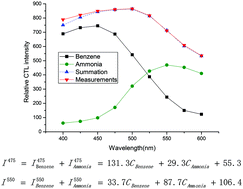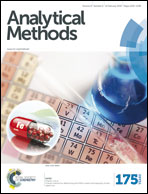A new cataluminescence-based gas sensor for simultaneously discriminating benzene and ammonia
Abstract
An efficient method based on cross-cataluminescence (CTL) on nano-Bi4SnV2O13 was proposed for simultaneously discriminating benzene and ammonia in air. The experimental conditions meeting the algebraic sum rule of the CTL intensities of benzene and ammonia were sought. They are two analysis wavelengths of 475 nm and 550 nm, the surface temperature of sensing materials of 150 °C and the flow rate of air carrier of 250 ml min−1. The limits of detection of this method were 0.12 mg m−3 for benzene and 0.21 mg m−3 for ammonia. The linear ranges of CTL intensity versus analyte concentration were 0.2–66.3 mg m−3 for benzene and 0.4–81.7 mg m−3 for ammonia. The recoveries of 10 tested standard samples by this method were 97.1%–102.2% for benzene and 97.6%–103.1% for ammonia. Common coexistence matters, such as toluene, ethylbenzene, methylamine, ethylamine, formaldehyde, acetaldehyde, methanol, ethanol, sulfur dioxide and carbon dioxide, did not disturb the determination. The relative deviation (RD) of CTL intensities was less than 2% for continuous 120 h detection for a gaseous mixture containing benzene and ammonia , which demonstrated the longevity and steady performance of nano-Bi4SnV2O13 in the presence of benzene and ammonia.


 Please wait while we load your content...
Please wait while we load your content...